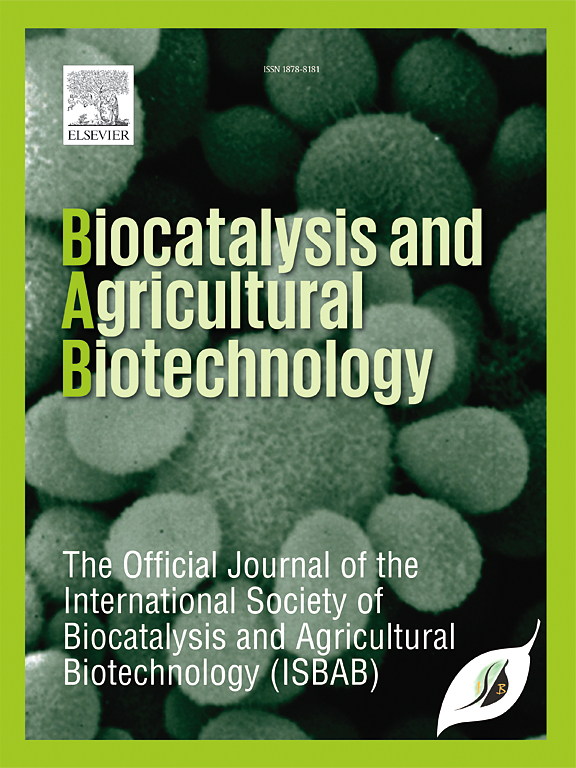伊施瓦龙:一种新型环保型植物杀菌剂,可诱导埃及伊蚊(1762)和达林按蚊(1926)的氧化应激和防御酶活性。
IF 3.4
Q2 BIOTECHNOLOGY & APPLIED MICROBIOLOGY
引用次数: 0
摘要
埃及伊蚊和达林按蚊是巴西登革热和疟疾的媒介。目前,控制它们的一种替代方法是使用精油(EOs)及其分离化合物,由于它们对非目标动物的毒性较低,因此是管理幼虫的环境友好剂。为此,本研究分离了阿拉皮绿枝派蚊的EO及其主要化合物,并对其幼虫的作用进行了评价,重点探讨了其作用机制。这些产品对非靶动物的致死效果也进行了评估。利用一维、二维NMR和HRAPCIMS数据,确定了新型倍半萜6-ishwarone的结构。6-Ishwarone和EO均表现出杀虫活性(LC50为25.03 ~ 42.58 μmol/ mL),并伴有活性氧和活性氮的过量产生(36.67±7 ~ 49.33±1%),谷胱甘肽s -转移酶(36.00±8 ~ 80.67±7 μmol/min/mg蛋白)和过氧化氢酶(0.31±0 ~ 0.50±0 μmol/min/mg蛋白)活性升高。随后乙酰胆碱酯酶活性降低(36.00±8 ~ 25.33±1 μmol/min/mg蛋白),硫醇含量降低(30.00±3 ~ 13.33±3 μmol/mg蛋白)。6-ishwarone和EO (LC50为415.25 ~ 739.29 μg/mL)对布氏胸蚜、splendens胸蚜、G. affinis和indicus的毒性均低于α-氯氰菊酯(LC50为0.23 ~ 0.35 μg/mL)。这些发现强调了这些产品在开发新的蚊虫控制策略方面的潜力。本文章由计算机程序翻译,如有差异,请以英文原文为准。

6-Ishwarone: A novel eco-friendly botanical biocide inducing oxidative stress and disrupting defense enzyme activities in Aedes aegypti Linnaeus, 1762 and Anopheles darlingi Root, 1926 (Culicidae)
Aedes aegypti and Anopheles darlingi are vectors of dengue and malaria in Brazil. Currently, a alternative for their control is the use of essential oils (EOs) and their isolated compounds, which are environmentally friendly agents for larval management due to their low toxicity to non-target animals. Thus, in the study, the EO from Piper alatipetiolatum and its main compound were isolated and evaluated against larvae these mosquitoes, focusing on the mechanism of action. The lethal effect these products were also evaluated against non-target animals. The structure of the 6-ishwarone, a new sesquiterpene, was established using 1D and 2D NMR and HRAPCIMS data. 6-Ishwarone and the EO exhibited larvicidal activity (LC50 from 25.03 to 42.58 μg/mL), accompanied by an overproduction of reactive oxygen and nitrogen species (36.67 ± 7 to 49.33 ± 1 %), an increase in both glutathione S-transferase (36.00 ± 8 to 80.67 ± 7 μmol/min/mg protein) and catalase activities (0.31 ± 0 to 0.50 ± 0 μmol of H2O2 consumed/min/mg of protein), followed by a decrease in acetylcholinesterase activity (36.00 ± 8 to 25.33 ± 1 μmol/min/mg protein) and a reduction in thiol content (30.00 ± 3 to 13.33 ± 3 μmol/mg protein). Furthermore, 6-ishwarone and the EO (LC50 from 415.25 to 739.29 μg/mL), were less toxic to A. bouvieri, T. splendens, G. affinis, and D. indicus compared with α-cypermethrin (LC50 from 0.23 to 0.35 μg/mL). These findings underscore the potential of these products for developing new mosquito control strategies.
求助全文
通过发布文献求助,成功后即可免费获取论文全文。
去求助
来源期刊

Biocatalysis and agricultural biotechnology
Agricultural and Biological Sciences-Agronomy and Crop Science
CiteScore
7.70
自引率
2.50%
发文量
308
审稿时长
48 days
期刊介绍:
Biocatalysis and Agricultural Biotechnology is the official journal of the International Society of Biocatalysis and Agricultural Biotechnology (ISBAB). The journal publishes high quality articles especially in the science and technology of biocatalysis, bioprocesses, agricultural biotechnology, biomedical biotechnology, and, if appropriate, from other related areas of biotechnology. The journal will publish peer-reviewed basic and applied research papers, authoritative reviews, and feature articles. The scope of the journal encompasses the research, industrial, and commercial aspects of biotechnology, including the areas of: biocatalysis; bioprocesses; food and agriculture; genetic engineering; molecular biology; healthcare and pharmaceuticals; biofuels; genomics; nanotechnology; environment and biodiversity; and bioremediation.
 求助内容:
求助内容: 应助结果提醒方式:
应助结果提醒方式:


